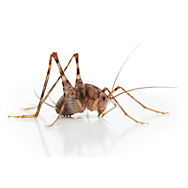Common Species: Greenhouse Camel Cricket
The greenhouse camel cricket (Diestrammena asynamora) is an insect species that originated in China and first began appearing in North America in the 1900s. Once in North America, these moisture-loving insects appeared to establish themselves only in greenhouses of the southeastern U.S.
However, a recent study has concluded that the greenhouse camel cricket has spread into human habitations and become the dominant indoor cricket species in many homes.
Appearance

The greenhouse camel cricket has a spider-like appearance thanks to its long legs. In fact, many people call them “sprickets,” a nickname created by merging “spiders” with “crickets.” Sprickets are covered with alternating bands of tan set off by darker browns.
The characteristics that best describe the greenhouse camel cricket are:
- Banded exoskeleton with dark brown and tan markings
- Long antennae that are twice the length of the body
- Two small horns are located between antennae
- Adult body length: A little more than a ½ inch
- Six legs, all of which are quite thin and long
- Strong jumpers – up to 4 feet!
- Has wings but cannot fly (many other cricket species can)
- Does not chirp
Habitat
Outside of the home, look for greenhouse camel crickets beneath stones and logs, in piles of wood or in areas overgrown with ivy and other ground cover.
Inside structures, they seek out dark, humid spaces such as in basements or wall voids near bathrooms. In greenhouses, they hide among plant foliage, and under planters or tables until dark.
Geography
In North America, it’s not clear exactly how far the greenhouse camel cricket has spread. At the very least, reports show these insects have spread as far north as New York’s Long Island and as far west as Texas. Their original foothold was established in the southeastern U.S.
Diet
The greenhouse camel cricket is an opportunistic scavenger and will feed on a variety of organic material. In greenhouses, it is known to damage young plants. When trapped in a basement with little food, it’s believed that these insects become cannibalistic.
Threat
Basement invasions by greenhouse camel crickets pose little in the way of health threats to humans and they are not known to bite humans either. These crickets can reach infestation levels, even in a small basement, and as a result, their very presence can be unsettling to most people.
Reproduction
Little scientific research has been done into the reproduction methods of camel crickets, but most assume that camel cricket females engage in the same strategies as other cricket species.
Control Options
If greenhouse camel crickets are invading your home, TERRO® has several options:
- TERRO® Spider & Insect Traps- Place these non-toxic sticky traps around the area where you see these crickets.
- Scorpion Killer Spray or Ant Killer Spray - Spray the area with one of these kill-on-contact insecticides. Once applied, the spray lasts up to 6 weeks.
- Spider Killer Spray- Another kill-on-contact spray option.
- TERRO® Stink Bug Killer Aerosol Spray- Can be used as a broad treatment or crack-and-crevice application.
- TERRO® Ant Dust- Apply this fine insecticide powder in cracks and crevices where these crickets may congregate.
- TERRO® Perimeter Ant Bait Plus- This weather-resistant outdoor granular bait kills crickets that eat it.
- TERRO® Ant Killer Plus - A spreader is built into the packaging of this outdoor granular insecticide.
- TERRO® Multi-Purpose Insect Bait- Apply multi-purpose insect bait around the perimeter of your home with its shaker container.
